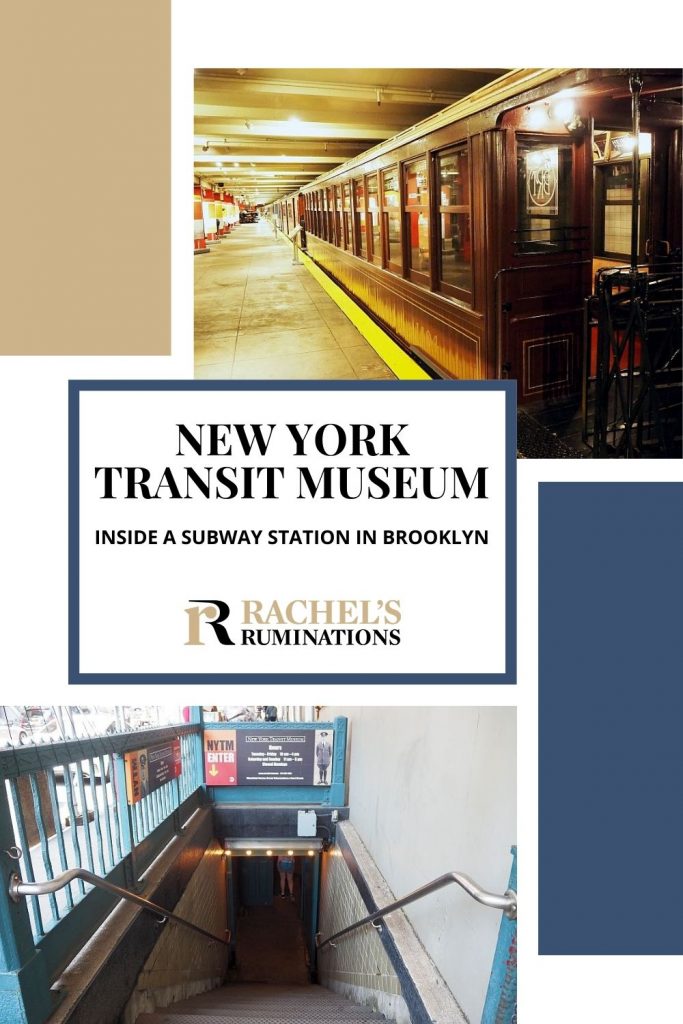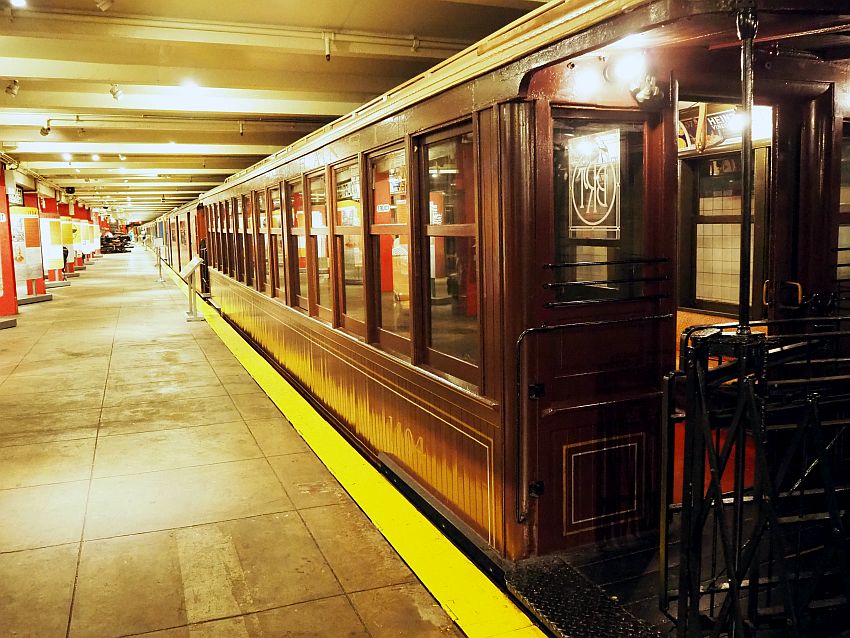The New York Transit Museum in Brooklyn
With its bewilderingly complicated passages, dank smell, bare concrete floors, tangles of pipes and conduits, and the rumbling roar that shakes the ground and then fades, the New York City subway system doesn’t win any prizes for beauty. It’s immense, though, and remarkably fast and efficient, and can take passengers within a few blocks of anywhere in the five boroughs for only $2.75.
Disclosure: This article contains affiliate links. If you click on one of them and make a purchase, I will receive a small commission. This will not affect your price.

Did you ever wonder, as you waited for a New York City subway train on a crowded platform or hung on for dear life as the train sped around a curve in the dark, how this vast transport system came to be? If so, the New York Museum of Transit is the place to find out.
Where in Brooklyn is the Transit Museum?
But first, you have to find it! It’s easy to miss the entrance. It looks, as you walk down an ordinary sidewalk in central Brooklyn, like the entrance to any subway station: a stairway down from the sidewalk, edged with a railing. I’m sure there are people who pass it every day who don’t know it’s there. And there must be people who enter it every day, then, startled, turn around and climb the stairs again when they realize it’s not, in fact, a subway station.

To be fair, the NY Transit Museum is housed in an unused subway station. You’ll even feel the occasional rumble, but the cleanliness level and smell are distinctly better than your average station. The museum extends the length of a city block, using two levels of a 1930s-era station. (See the bottom of this article for more detailed instructions on where to find the museum.)
Here are some other things worth seeing and doing in New York City:
- Walking across the Manhattan Bridge and the Brooklyn Bridge
- Museum of Chinese in America
- The African Burial Ground
And here’s a complete listing of free or cheap things to do: New York City on a Budget
What will you see in the Transit Museum?
Here you can learn how New York City public transport came to be, starting from its early incarnations using horse-drawn trams to the development of steam-powered and, later, electric trains running on elevated railways and/or through subway tunnels.
The emphasis is often on the people who worked on the transit system, either building it or operating it. How much did they earn? But also: how much did their money buy? (In 1915, drivers earned $4.50 a day, while laborers got $1.50. A hot dog cost 5 cents and a haircut 10 cents.) What did their jobs entail? (In general, it was hard physical work with long hours.) How exactly did they build the tunnels? And so on.

Much of the first section of the museum is fairly dry, with signs and photographs on walls and objects in cases – vintage change dispensers, tram models and such – but it gets better as you move along the platform. Vintage train cars line the platform as if they’re waiting for passengers to board.
Train cars
Only the informational sign outside each one betrays that something else is happening here. The signs tell more information than you probably would ever want to know about the age of the car, how and by whom and why it was produced, how it was powered, and so on.
It’s worth at least skimming them, though, because of the interesting details you’ll learn. Did you know …
- that wooden trains on steel underframes were first pulled by steam locomotives before the subway system was electrified? It was smelly and smoky.
- that the wooden cars were removed from subway tunnels and only used on elevated lines after an accident in 1918 involving wooden cars? Transit workers were on strike, and the driver was essentially unqualified. Pulling 650 passengers, he took a curve too fast and the train derailed. Two of the wooden cars fell apart and 93 passengers were killed.
- that the new steel cars developed next were too heavy to use on the elevated lines? So for some time, the elevated lines used wooden cars while the underground lines used steel cars.
The train cars on show range from the first decade of the 1900s to the 1970s. The signs make clear why some are wood and some are metal and how and why the designs changed over time. For me, it was odd to see a subway car whose 1970s interior brought back childhood memories of trips into the city with my family or, as a teenager, with my friends. The feeling was akin to the time I saw my first desktop computer (a Mac 512 enhanced) on display in a museum. It made me feel ancient.

There are also a few vintage ticket kiosks (including the one at the entrance where you buy your ticket to the museum) as well as vintage turnstiles.
While the emphasis is on the subways, some attention is also given to the bus network that makes up another important part of New York City’s mass transit system.
Planning a trip to New York City? Use the map below to book your accommodation:
Advertisements in the trains
Visitors can board the train cars and get a clear sense of each car’s era. You can see this not only because of the car itself – Is the train car made of wood? Are the seats upholstered? And that bright orange could only be from the 1970s! – but because of the advertisements posted in each one.

Riding a subway car is often an exercise in people-watching. When the train travels through dark tunnels, there’s nothing to see out the windows. This makes it a great place for companies to advertise; they have a captive audience. Reading the advertisements along the walls of the car, above the windows, helps you avoid eye contact as well.

I ended up spending more time at the New York Transit Museum than I had intended because I was busy reading the ads. In each car, they matched the period when that car was used. It’s a lesson in the history of advertising, though unfortunately the ads have no informational signs to go with them.

Is the New York Transit Museum worth visiting?
If you’re interested in urban transportation, the New York Transit Museum is worth visiting. If you have kids who are train-crazy, they’ll enjoy it, though it won’t take them long to exhaust what the Transit Museum has to offer.
I’d also recommend the museum to anyone interested in the history of advertising. While there is no extra information about the ads, they’ve clearly been curated. They fit in terms of chronology with each other and with the train car they’re in. You could probably find the ads online, but here you see them in their intended context and time period.
Even with skimming most of the informational signs and dawdling over the ads, I only spent a bit over an hour in the museum.

Getting to the Transit Museum in Brooklyn
Ironically, though you can (and should!) take the subway to get to the museum, you’ll have to walk to it from another nearby subway station.
- If you’re taking the A or C train, get off at Hoyt-Schemerhorn Station and walk for 4 minutes northwest on Schermerhorn Street until you reach the intersection with Boerum Place. You’ll find the museum there.
- If you’re taking the 2 or 3 train, get off at Borough Hall Station and walk south on Boerum Place for about 4 minutes to the corner of Boerum Place and Schermerhorn Street.
The museum entrance is a long stairway, but there is also a wheelchair lift at the other end of the old station platform, at the corner of Schermerhorn and Court Street. The museum is almost entirely wheelchair accessible, since the exhibits are all along two flat station platforms. The station has two floors, but with a wheelchair lift between the two levels. Some of the older train cars are not accessible because of narrow doorways.
Admission: Adults $10, Children 2-17 $5.
Check their website for opening hours.
The Transit Museum also runs a small gallery and store inside Grand Central Station, off the Main Concourse, near the Station Master’s Office. Admission is free.





Pretty sure those red-orange- yellow seats were NOT from 1972; try 1982…
I think they’re both – they were produced in the 70s and 80s and I think they may still be in some cars today, though they’re not produced anymore.